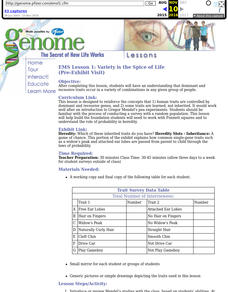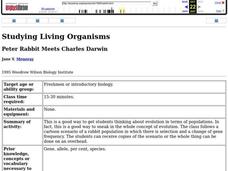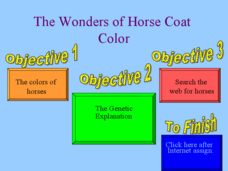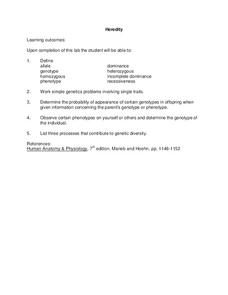Curated OER
Raven Chapter 13 Guided Notes: Patterns of Inheritance
In this short space, it would be impossible to describe the breadth of this seven-page genetics learning exercise. Geared toward AP or college biology learners, they explore not only the basic vocabulary and concepts, but also the Law of...
Curated OER
"Easter" Egg Genetics
Using plastic Easter eggs to represent parent phenotypes, genetics enthusiasts simulate the passing of alleles. They record the phenotype of each half of the egg, one representing the mother's and one representing the father's. They...
Curated OER
Genes within Populations
Finally, here is a genetics worksheet that does not include Punnett squares! Designed for a more advanced class, biology learners will compare Lamarck's concept of evolution with Darwin's. They will explore the Hardy-Weinberg equilibrium...
Curated OER
Heredity Worksheet #1
In this genetics worksheet, students review the experiments on pea plants that Mendel used to explain dominant and recessive alleles. This worksheet has 10 fill in the blank questions.
Curated OER
EMS Lesson 1: Variety is the Spice of Life
Students discern that dominant and recessive traits occur in a variety of combinations in any given group of people.
Curated OER
Rock, Paper, Scissors
Students explore the concept of dominant and recessive genes by examining the dominant and recessive characteristics of a game of rock, paper, scissors. In small groups students play the game and explain how one move is dominant over...
Curated OER
Variety is the Spice of Life
Young scholars explore Gregor Mendel's work with genetics. They complete a survey of their friends and family in order to identify dominant and recessive traits. Once their surveys are complete, students discuss the ways in which...
Curated OER
Fun with Heredity
Students explore basic concepts of heredity and collaborate to see genetics in action through several activities provided in the lesson. Inherited traits are examined and identified as dominant or recessive.
Curated OER
Heredity
In this heredity learning exercise, students review how genes are involved in the inheritance of certain traits through generations. Students complete a Punnett square and review probability. This learning exercise has 11 short answer...
Curated OER
Heredity (Mendelian Genetics)
Students observe and record observations of whether a person is a taster or nontaster. They test selected individuals from their families and peer groups and chart all findings to determine which trait (e.g. taster or non-taster) is...
Curated OER
Sex-Linked Genes and Disorders
In this genes worksheet, learners determine how the gender of a baby is produced plus explore sex-linked disorders such as hemophilia. This worksheet has 20 fill in the blank and 8 short answer questions.
Curated OER
Peter Rabbit Meets Charles Darwin
Ninth graders explore evolution. They study a cartoon scenario of a rabbit population in which there is selection and a change of gene frequency. Students discuss frequencies, evolution, and speciation.
Curated OER
It's in the Genes!
Help your students discover more about themselves with these great lesson ideas involving heredity, genetics, and Punnett Squares.
Curated OER
Bikini Bottom – Dihybrid Practice
For this biology worksheet, students use the chart to identify the genotypes of each of the traits listed related to Sponge Bob. Then they identify the genotypes of each of the family members as given. Students also complete the Punnett...
North Carolina State University
Exploring Genetics Across the Middle School Science and Math Curricula
Where is a geneticist's favorite place to swim? A gene pool. Young geneticists complete hands-on activities, experiments, and real-world problem solving throughout the unit. With extra focus on dominant and recessive genes, Punnett...
Curated OER
Zork Genetics
In this genetics worksheet, students use an imaginary species and a list of genetic traits and the alleles that code for each trait to determine the genotype and phenotype probabilities of offspring. Students complete nine monohybrid...
Curated OER
The Genetics of Parenthood
High schoolers draws the child's face and compares "mother's" and "father's" perception of characteristics. One student draws the child's face; partner writes a biography of the child at age 30- what is the child like, what have they...
Curated OER
An Inventory of My Traits
In this biology activity, students identify and describe a number of easily observable genetic traits and compare the traits they have with other students. Then they identify and describe that some traits are common while others are not...
Curated OER
The Wonders of Horse Coat Color
You won't be able to use a few of the slides in this presentation since the first lists objectives not met within, and the third gives instructions to a worksheet that is not included. You will, however, find the remaining slides useful...
Curated OER
A Look Into the Past
Students practice looking at their genetics to inquire about their past. In groups, they determine their recessive and dominant genes and plot their height on a graph. They compare and contrast the processes of meiosis and mitosis. ...
Curated OER
Heredity
In this science worksheet, students find the answers to various types of heredity problems. They use the sheet to set goals for completing the unit.
Scholastic
Study Jams! Heredity
Mia wishes her blue hair was inherited so that she wouldn't have to dye it, but Sam explains that eye color is. The video does not expound upon the concept of alleles. It does, however, describe inherited traits vs. learned behavior, and...
National Center for Case Study Teaching in Science
In Sickness and in Health
Based on family history, how likely is it that a couple's children will have a recessive disease? In an in-depth, but easy-to-follow case study, future geneticists learn the story of Greg and Olga, who are hoping to have children, but...
US National Library of Medicine
Genetics in Harry Potter’s World Lesson 2
Can we find the phenotypes and genotypes of magical ability for the characters in Harry Potter? Of course, but first we need to understand incomplete or blended dominance, co-dominance, multiple alleles, and regulatory genes. This...

























